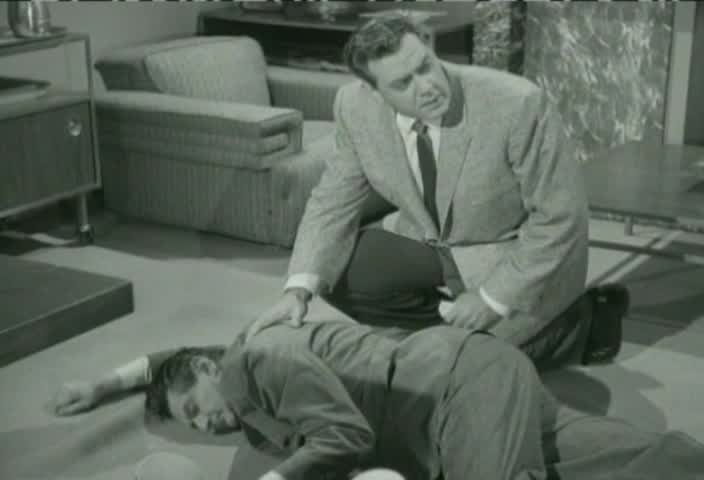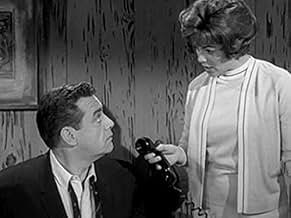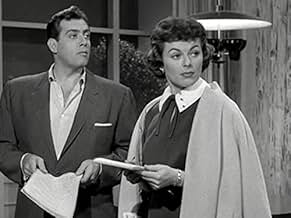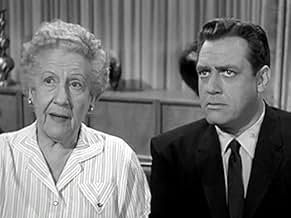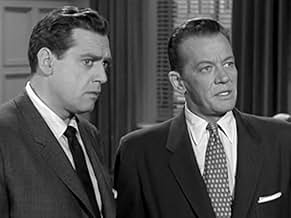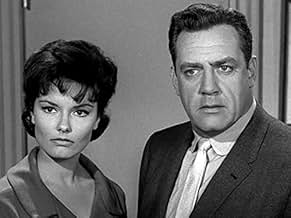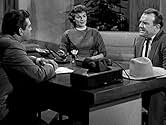The trials of a master criminal defense attorney handling the most difficult cases in support of the innocent.The trials of a master criminal defense attorney handling the most difficult cases in support of the innocent.The trials of a master criminal defense attorney handling the most difficult cases in support of the innocent.
- Won 3 Primetime Emmys
- 7 wins & 7 nominations total
Browse episodes
Featured reviews
The "Perry Mason" character, as developed by Erle Stanley Gardner in the early 1930s, was a "fighter", in the author's words; like Gardner himself, a successful and ingenious lawyer, the fictional lawyer-detective enjoyed seeking out the truth in the field--whether he was finding a body, bending a law in order to fight for his client or testing an hypothesis--as much as he enjoyed arguing a case within the arena of a courtroom. Immensely popular from the beginning, the character was never changed by Gardner. And although the series on television was subtly altered in many ways, and enjoyed format alterations, I assert that nothing essential was ever altered about Mason nor his main "foils". At the beginning, the cast consisted of Raymond Burr as Mason, William Hopper as his detective pal Paul Drake, pretty Barbara Hale as his right-hand girl and secretary Della Street, William Talman as Hamilton Burger his chief courtroom enemy, and Ray Collins as Lt. Arthur Tragg of Homicide. Cases began in many different ways; chiefly with a future accused murderer being victimized by someone else, or with a client coming to ask Mason's help. Had the show's writers found a way to state a categorical purpose for Mason to explain why he was taking each case, the fine power of these dramatic stories could have been increased. But the chief quality of the interesting narratives I suggest was rather, usually, watching Mason trying many ways to find out the truth about what had been done in some situation in order to prove the innocence of his client of a murder; that, plus the many characters who people over 250 separate episodes. Many fine writers and directors created stories for "Perry Mason"; some episodes were adaptations of Mason novels. And with Gardner working closely with executive producer Gail Patrick Jackson, the original entries were held strictly and successfully to the author's conception of the character. Talents as famous as Jack Arnold, Earl Bellamy, László Benedek, script consultant Arthur Marks, Arthur Hiller, Ted Post, Vincent Mceveety, Robert Sparr, Gerd Oswald, Andrew Mclaglen and Christian Nyby were in charge of the "Mason" cameras; writers for the series included True Boardman, Robert C. Dennis, John Elliotte, Jackson Gillis, Laurence Louis Goldman, Seeleg Lester, Orville H, Hampton, Laurence Marks, Bob and Esther Mitchell Jonathan Latimer, Samuel Newman, Helen Nielsen, Mann Rubin, Sy Salkowitz, Stirling Silliphant, Barry Trivers, Al C. Ward, Maurice Zimm and Gene Wang, among others. Mason employed a young lawyer, played by Karl Held, for one season; Richard Anderson, Wesley Lau, Dan Tobin and Lee Miller were regulars for varying lengths of time. But the glory of the series, i assert, was its guest stars. Apart from younger actors chosen for their looks, almost every other part was well-cast and the enactors successful in creating a character. The producers also used only about ten judges, notably S. John Launder, Willis Bouchey, John Gallaudet, Kenneth Macdonald and one female jurist. But the courtrooms in which Mason appeared ranged all over the state of California, from a military tribunal to small town courts to the great Los Angeles arena. Almost as numerous were the sites where Mason and Drake discovered clues, bodies and trouble; because Mason was a fighting man at heart, his favorite ploy was to plant false evidence to force overworked police to investigate some aspect of the case, to meet with someone in order to goad them into revealing something and to dispatch Drake or other operatives to expand his power of search and investigation. For me as a writer and viewer, the fun lay not so much in solving the crime along with Mason--although guessing the murderer's identity was enjoyable--but in watching the fine actors hired to don hats (as devices of characterization) and to take part in an interesting ethical exercise. Mason's ingenuity and lack of pretension endeared him to me, and to millions of viewers. Fine composers such as Jerry Goldsmith and Fred Steiner, who created the show's them, worked for the producers; and the cinematography and lighting was always above average for B/W television. But guest stars such as Keith Andes, Walter Pigeon, Whitney Blake, Pippa Scott, Cecil Kellaway, Gail Kobe, Paul Cavanagh, Benson Fong, Stacy Graham, Douglas Kennedy and Vaughn Taylor at last were who kept me, and other viewers, coming back every week. This is a most watchable narrative program; one-of-a-kind and still very enjoyable.
10twanurit
One can tell the timeless longevity of a television series by the condition if it's still playing on TV. "Perry Mason" (1957-1966) is! It followed a tried-and-true formula: the first half-hour the situation is developed, then there's a murder. The second half-hour is filled with courtroom dramatics, to find the killer. But this is considerably heightened by a moody musical score, shadowy, gripping B&W photography, incisive scripts, magnificent guest stars (many who appeared multiple times), and lastly the brilliant ensemble cast headed by Raymond Burr, with Barbara Hale, William Hopper, William Talman and others. The series was re-done (poorly) in 1973, the more recent 2 hour TV movies were padded and don't hold up to repeated viewings. Voted the top dramatic series by TV Guide, it just does not get any better. Case closed.
Perhaps the most successful formula show in the history of TV. An interesting question is why, since the lead characters never varied, the outcome was predictable, and the plots could at times defy expert analysis. To me, that sounds pretty boring. So why did I faithfully watch the first runs and still catch the reruns when I can, and why did the series catch the fancy of so many others as it still does. Here are some conjectures.
Mason, Street, and Drake are more than a team-- they are a family. The chemistry among them is so good it's almost spooky. Burr's Mason is nothing if not masterful both inside the courtroom and out. He's a strong father-figure, while Hale's Della Street is the perfect secretary, sweet, attractive and highly efficient. Not quite a mother-figure (after all, this is a chaste family), she's the perfect older sister. And Hopper's Paul Drake is clever, charming, and slightly rakish. All in all, he's the perfect younger brother. Though each is a professional, together they operate as a loyal family unit. And when their final scene rolls around (The Final Fadeout, 1966), we're happy to know they will remain together even though we (the viewers) won't be with them.
The key here is Burr's grasp of character. After all, Mason wins week after week-- he never misses. What's more, he shows up the guardians of law and order week after week. If not done right, Mason would be an easy character to dislike. But Burr's Mason is never smug, never immodest, and always low-key, so we don't resent his near god-like status. This is a real tribute to Burr and the show's producers, who managed to walk a very fine line. There's one other character point worth noting. Mason's personality is the only one of the five (Burger and Tragg included) to alter. In the early episodes, he smokes, wears loud jackets, and occasionally flirts. But with the show's success, he's transformed into a paragon of virtue, probably because his character has come to stand for the quality of criminal justice in America. Shrewdly, the producers would take no chances with their golden egg.
The engaging quality of the stories varies little, an unusual feature for any formula show. That's likely because the script-writers worked with variations on six or seven basic plots. After all, they had to come up with thirty-plus mysteries every year for nine years. And each episode had to have a plausible list of suspects with a story line to unravel, which is a pretty heavy load. Then too, each entry had to have a larger than average cast of capable actors as suspects. Watching the re-runs, we see just about every familiar face from that era (one of the joys of catching the re-runs). Executive producer Gail Patrick Jackson deserves a lot of behind-the-scenes credit, since I'm sure this was not an easy series to put together week after week.
I had never thought of the show as film noir. But other reviewers have correctly pointed this out. Indeed, there are elements of noir in many of the first half hours, where the mystery sets up. Many of these were done in shadow, with strong emotions and a heavy atmosphere of doom, which distinguishes the series. For, overall, there was very little noir from any series during that sunny era. Frankly, it's that part I always enjoyed more than the courtroom scenes with their high-key lighting and extended dialogue. The general excellence of these first half- hours is another reason, I think, for the show's unusual success.
The mystery angle remains an attraction for many. It's fun, for those who want, to try to figure out the culprit. We know he or she will be exposed and the loose ends tied-up by hour's end. But the entries can be enjoyed for their drama alone. The witness-stand confessions served as a chance for neglected feature players to show their acting chops. Some of these were truly memorable. My favorite is from that great unsung actress of the era, Constance Ford. Watch her split personality emerge under Mason's perceptive grilling (The Case of the Deadly Double, 1958). It's a dramatic tour-de-force, as good as anything from the movies of the time. Many of the confessions were also poignant. The culprit could be seen as a sympathetic character, driven to murder by larger forces. And though, the epilogue (usually in Mason's office) often ended on a humorously upbeat note, the confessions remain the dramatic high point.
These are some of my best guesses. I expect there's another, not so flattering reason. Many of us, of course, have a nostalgic attachment to those younger years, which, I suppose, is only natural. Nonetheless, there is something timeless about the brave knight rescuing unfortunates in distress (in this case, usually a shapely blonde or brunette). In fact, the Mason show was predicated on that venerable premise. And even though Mason-as-ideal-defense-attorney would probably not work in today's post-Vietnam era, the key plot elements endure ( understandably, the series ended, just as the war in south-east Asia heated up). Greed, jealousy, ambition-- this is the stuff of high drama, while the Mason show used them effectively inside a format that fit its time. But the elements themselves remain timeless. And in that sense, so does the series.
Mason, Street, and Drake are more than a team-- they are a family. The chemistry among them is so good it's almost spooky. Burr's Mason is nothing if not masterful both inside the courtroom and out. He's a strong father-figure, while Hale's Della Street is the perfect secretary, sweet, attractive and highly efficient. Not quite a mother-figure (after all, this is a chaste family), she's the perfect older sister. And Hopper's Paul Drake is clever, charming, and slightly rakish. All in all, he's the perfect younger brother. Though each is a professional, together they operate as a loyal family unit. And when their final scene rolls around (The Final Fadeout, 1966), we're happy to know they will remain together even though we (the viewers) won't be with them.
The key here is Burr's grasp of character. After all, Mason wins week after week-- he never misses. What's more, he shows up the guardians of law and order week after week. If not done right, Mason would be an easy character to dislike. But Burr's Mason is never smug, never immodest, and always low-key, so we don't resent his near god-like status. This is a real tribute to Burr and the show's producers, who managed to walk a very fine line. There's one other character point worth noting. Mason's personality is the only one of the five (Burger and Tragg included) to alter. In the early episodes, he smokes, wears loud jackets, and occasionally flirts. But with the show's success, he's transformed into a paragon of virtue, probably because his character has come to stand for the quality of criminal justice in America. Shrewdly, the producers would take no chances with their golden egg.
The engaging quality of the stories varies little, an unusual feature for any formula show. That's likely because the script-writers worked with variations on six or seven basic plots. After all, they had to come up with thirty-plus mysteries every year for nine years. And each episode had to have a plausible list of suspects with a story line to unravel, which is a pretty heavy load. Then too, each entry had to have a larger than average cast of capable actors as suspects. Watching the re-runs, we see just about every familiar face from that era (one of the joys of catching the re-runs). Executive producer Gail Patrick Jackson deserves a lot of behind-the-scenes credit, since I'm sure this was not an easy series to put together week after week.
I had never thought of the show as film noir. But other reviewers have correctly pointed this out. Indeed, there are elements of noir in many of the first half hours, where the mystery sets up. Many of these were done in shadow, with strong emotions and a heavy atmosphere of doom, which distinguishes the series. For, overall, there was very little noir from any series during that sunny era. Frankly, it's that part I always enjoyed more than the courtroom scenes with their high-key lighting and extended dialogue. The general excellence of these first half- hours is another reason, I think, for the show's unusual success.
The mystery angle remains an attraction for many. It's fun, for those who want, to try to figure out the culprit. We know he or she will be exposed and the loose ends tied-up by hour's end. But the entries can be enjoyed for their drama alone. The witness-stand confessions served as a chance for neglected feature players to show their acting chops. Some of these were truly memorable. My favorite is from that great unsung actress of the era, Constance Ford. Watch her split personality emerge under Mason's perceptive grilling (The Case of the Deadly Double, 1958). It's a dramatic tour-de-force, as good as anything from the movies of the time. Many of the confessions were also poignant. The culprit could be seen as a sympathetic character, driven to murder by larger forces. And though, the epilogue (usually in Mason's office) often ended on a humorously upbeat note, the confessions remain the dramatic high point.
These are some of my best guesses. I expect there's another, not so flattering reason. Many of us, of course, have a nostalgic attachment to those younger years, which, I suppose, is only natural. Nonetheless, there is something timeless about the brave knight rescuing unfortunates in distress (in this case, usually a shapely blonde or brunette). In fact, the Mason show was predicated on that venerable premise. And even though Mason-as-ideal-defense-attorney would probably not work in today's post-Vietnam era, the key plot elements endure ( understandably, the series ended, just as the war in south-east Asia heated up). Greed, jealousy, ambition-- this is the stuff of high drama, while the Mason show used them effectively inside a format that fit its time. But the elements themselves remain timeless. And in that sense, so does the series.
"Perry Mason" was not only a great legal drama, but it was also a great whodunnit. Perry Mason's detective skills would serve him well in gathering evidence to prove his client's innocence. Also, the casting of Raymond Burr finally gave him his defining role after years of playing heavies. And let's not forget the supporting cast. Barbara Hale as Della Street, Perry's faithful secretary, William Hopper as Paul Drake, the able bodied gumshoe, William Tallman, as his nemesis district attorney Hamilton Burger and Ray Collins, as the always dogged Lieutenant Arthur Tragg.
For nine seasons and over 250 episodes Perry Mason ruled the television roost, it was the ratings flagship for CBS. Saturday nights at 7:30 this show was a viewing requirement in my household.
The show had a built in audience from the start with the millions of mystery fans who loved Erle Stanley Gardner's criminal defense attorney who always defended the innocent and never lost a case. Those parameters for the television series had to be respected. But also the right actor had to be found to play Mason.
One of the highest pieces of praise I ever read was Erle Stanley Gardner himself saying that Raymond Burr completely fitted his concept of the character he created. When you've got that kind of endorsement as well as the ratings to back it up, I'm sure the show could have run forever.
A really solid group of character players made up the cast here. Take a look at the credits on the pages here for Burr, Barbara Hale as Della Street, William Talman as District Attorney Hamilton Burger, William Hopper as Perry's private detective Paul Drake and Ray Collins as Police Lieutenant Tragg seem like they appeared in some of the best movies ever before going to series television.
Collins began experiencing health problems and first Wesley Lau and later Richard Anderson took the load from him. When Collins died in 1965 Anderson was the official cop for the series last year.
So indelible an impression this cast made on viewers minds that when CBS sought to revive Perry Mason in the middle seventies with a younger cast, the public viewed other stations in droves. Even with Collins, Hopper, and Talman all gone at that point, no one would accept their replacements.
The writers given the constraints of an hour television show managed to respect Erle Stanley Gardner's parameters and did a beautiful job with each and every episode.
This is what a good television series is all about.
The show had a built in audience from the start with the millions of mystery fans who loved Erle Stanley Gardner's criminal defense attorney who always defended the innocent and never lost a case. Those parameters for the television series had to be respected. But also the right actor had to be found to play Mason.
One of the highest pieces of praise I ever read was Erle Stanley Gardner himself saying that Raymond Burr completely fitted his concept of the character he created. When you've got that kind of endorsement as well as the ratings to back it up, I'm sure the show could have run forever.
A really solid group of character players made up the cast here. Take a look at the credits on the pages here for Burr, Barbara Hale as Della Street, William Talman as District Attorney Hamilton Burger, William Hopper as Perry's private detective Paul Drake and Ray Collins as Police Lieutenant Tragg seem like they appeared in some of the best movies ever before going to series television.
Collins began experiencing health problems and first Wesley Lau and later Richard Anderson took the load from him. When Collins died in 1965 Anderson was the official cop for the series last year.
So indelible an impression this cast made on viewers minds that when CBS sought to revive Perry Mason in the middle seventies with a younger cast, the public viewed other stations in droves. Even with Collins, Hopper, and Talman all gone at that point, no one would accept their replacements.
The writers given the constraints of an hour television show managed to respect Erle Stanley Gardner's parameters and did a beautiful job with each and every episode.
This is what a good television series is all about.
Did you know
- TriviaWhen Raymond Burr missed several episodes due to illness, he was replaced by several guest attorneys who were played by Bette Davis, Walter Pidgeon, Hugh O'Brian, Michael Rennie, and Mike Connors.
- GoofsPerry Mason's office is given as on the 9th floor of the fictional "Brent Building" in Los Angeles, and has a distinctive terrace outside (as does the next-door office in S.8 Ep. 30). However, establishing shots of the exterior use a photo of a plain-sided office building with no balconies or terraces on the 9th floor, or anywhere else.
- Quotes
Hamilton Burger: Incompetent, irrelevant, and immaterial!
- ConnectionsFeatured in Guêpier pour trois abeilles (1967)
Details
- Release date
- Country of origin
- Language
- Also known as
- Перрі Мейсон
- Filming locations
- Production companies
- See more company credits at IMDbPro
- Runtime1 hour
- Color
- Sound mix
- Aspect ratio
- 1.33 : 1
Contribute to this page
Suggest an edit or add missing content


